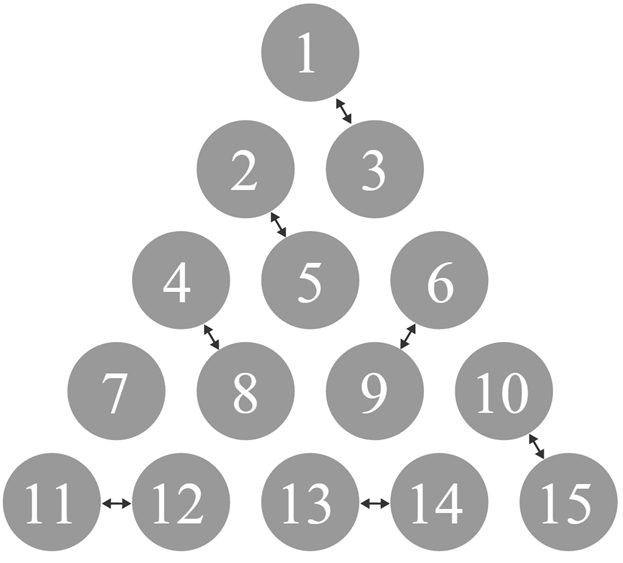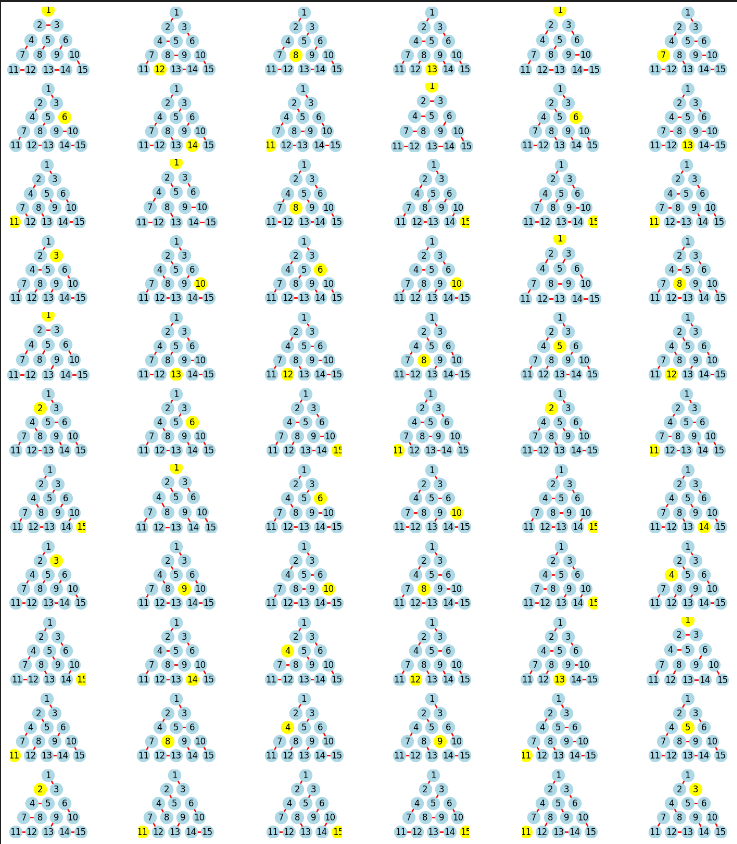Dancer Pairs
dancers are standing in an equilateral triangle formation, with every dancer standing unit apart from her nearest neighbors. Each dancer chooses another who is unit away to pair up with, and all but dancer ends up as a part of a pair. An example of one such arrangement is presented here.
How many different sets of pairs are possible?

Solution
We use a backtracking algorithm in the generate_all_pairings function to generate all possible combinations. The backtrack function:
-
Takes the current index, the current pairing, and the set of used nodes.
-
If we have 7 pairs, we add the current pairing to our list of all pairings.
-
For each node from the current index onwards:
-
If the node is already used, we skip it.
-
For each neighbor of the node:
-
If the neighbor is not used and has a higher index (to avoid duplicates), we create a new pairing with this pair.
-
We then recursively call backtrack with the updated pairing and used nodes.
-
-
-
We use frozensets to represent pairs and combinations of pairs, allowing us to eliminate duplicates easily.
The code below shows us that there are ways of pairing the dancers. Here are a few sample pairings:

Python code
import networkx as nx
from itertools import combinations
import matplotlib.pyplot as plt
import math
def create_dancer_graph():
G = nx.Graph()
edges = [
(1, 2), (1, 3),
(2, 3), (2, 4), (2, 5),
(3, 5), (3, 6),
(4, 5), (4, 7), (4, 8),
(5, 6), (5, 9), (5, 8),
(6, 9), (6, 10),
(7,8),(7, 11), (7, 12),
(8, 9), (8, 13), (8,12),
(9, 10), (9, 13), (9, 14),
(10, 14), (10, 15),
(11,12),(12,13),(13,14),(14,15)
]
G.add_edges_from(edges)
return G
def generate_all_pairings(G):
all_pairings = []
nodes = list(G.nodes())
def backtrack(index, current_pairing, used_nodes):
if len(current_pairing) == 7:
all_pairings.append(frozenset(map(frozenset, current_pairing)))
return
for i in range(index, len(nodes)):
node = nodes[i]
if node in used_nodes:
continue
for neighbor in G.neighbors(node):
if neighbor not in used_nodes and neighbor > node:
new_pairing = current_pairing + [(node, neighbor)]
new_used_nodes = used_nodes | {node, neighbor}
backtrack(i + 1, new_pairing, new_used_nodes)
backtrack(0, [], set())
return set(all_pairings)
# Create the graph
G = create_dancer_graph()
# Generate all combinations
all_combinations = generate_all_pairings(G)
print(f"Total number of combinations: {len(all_combinations)}")